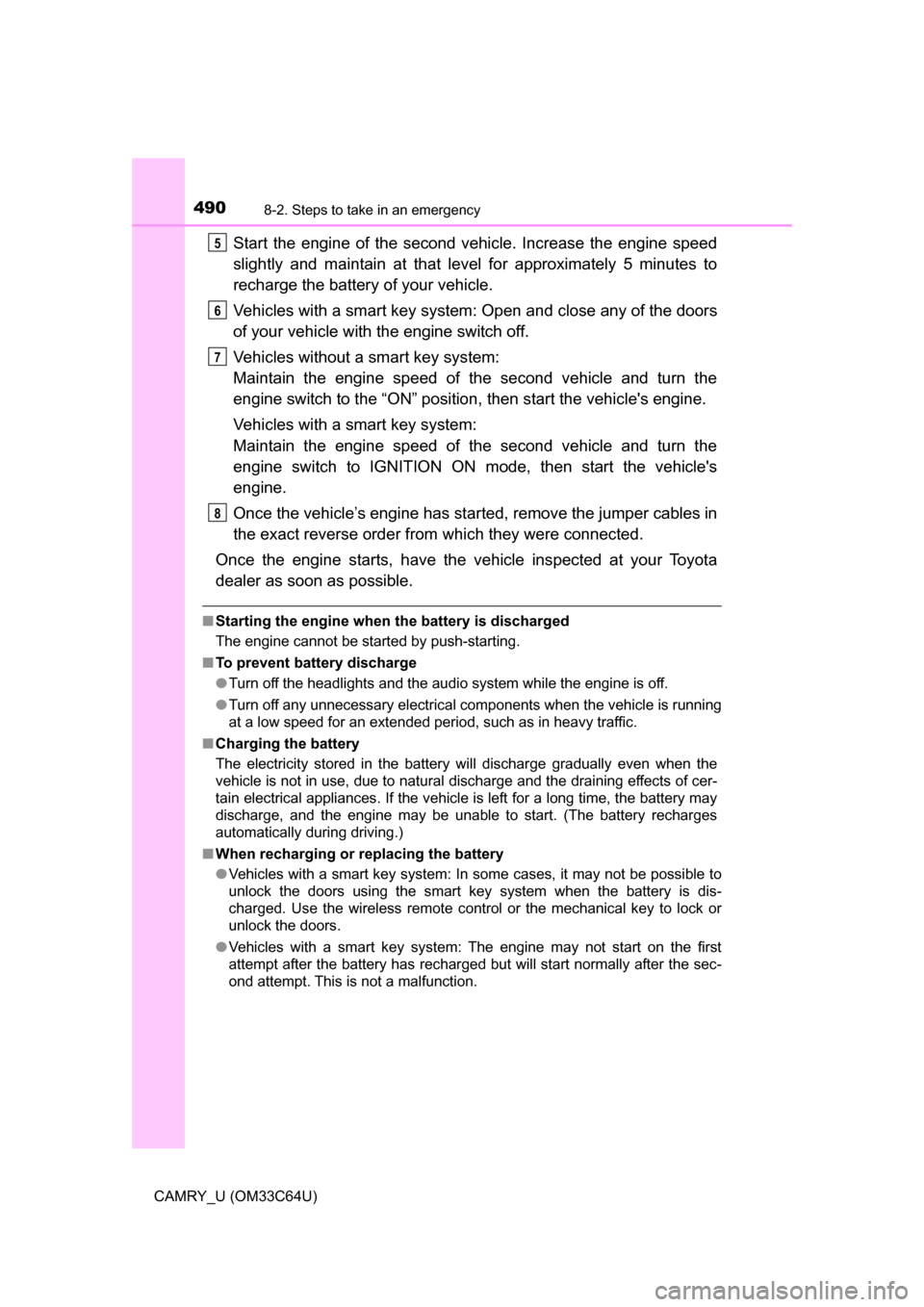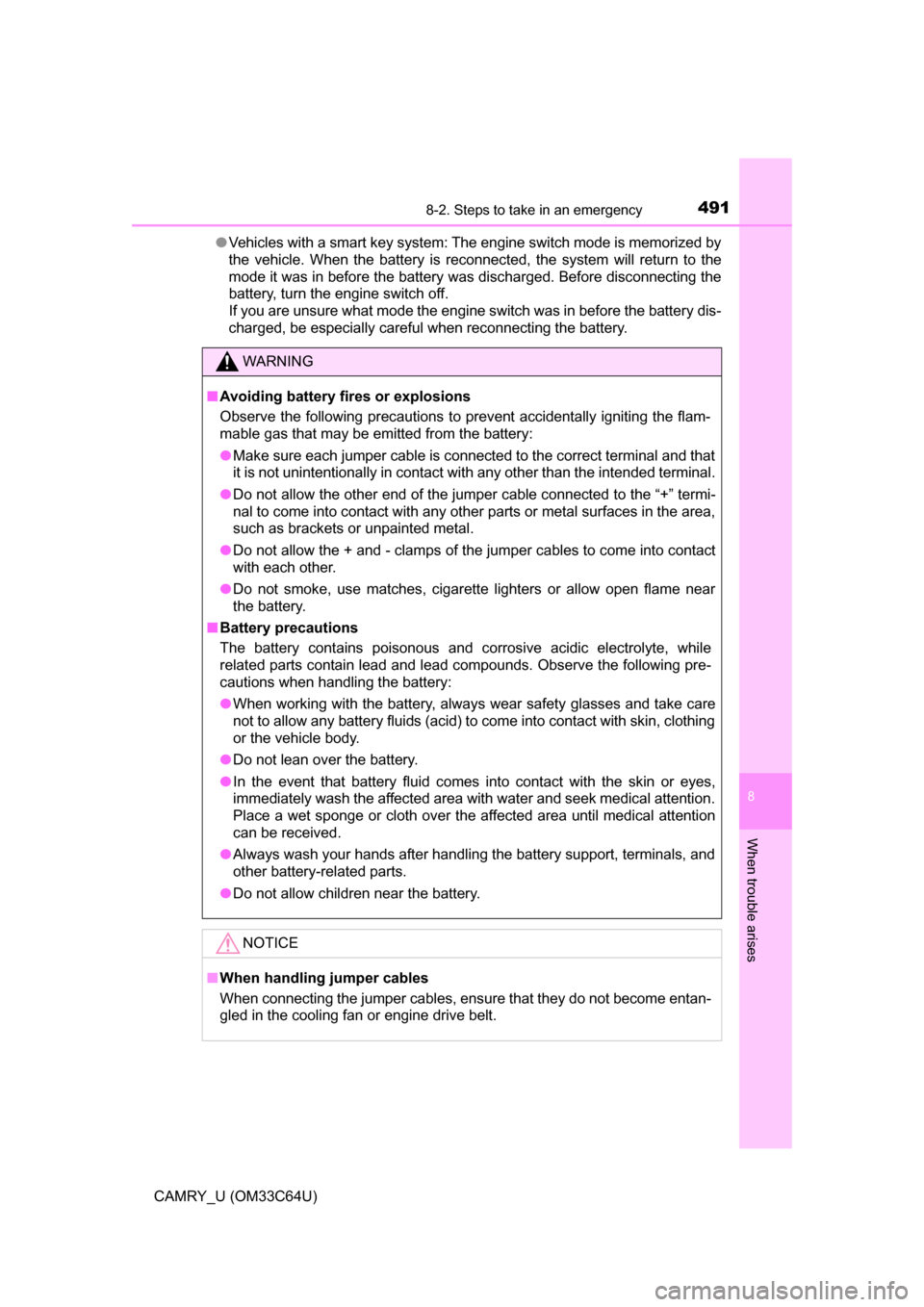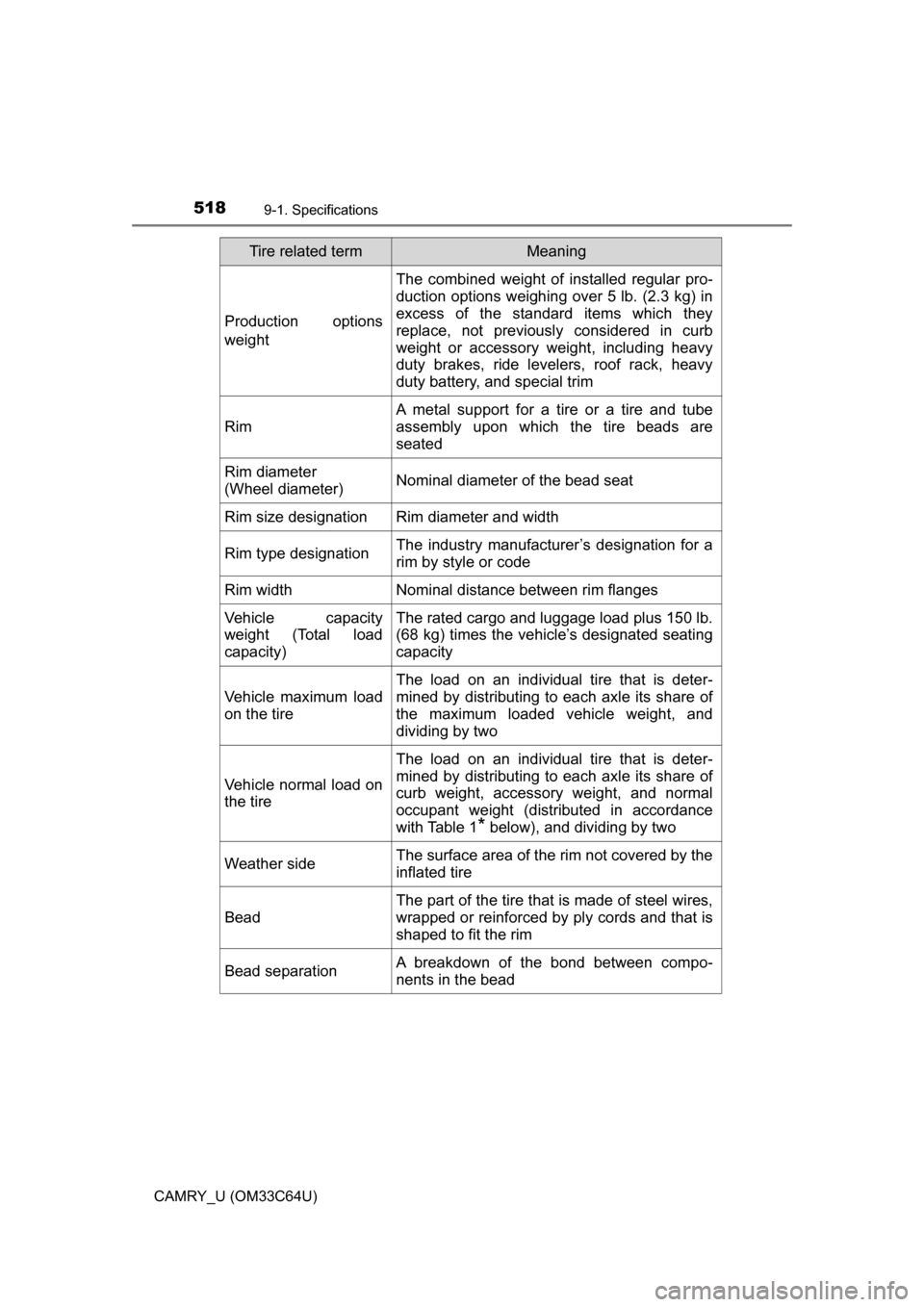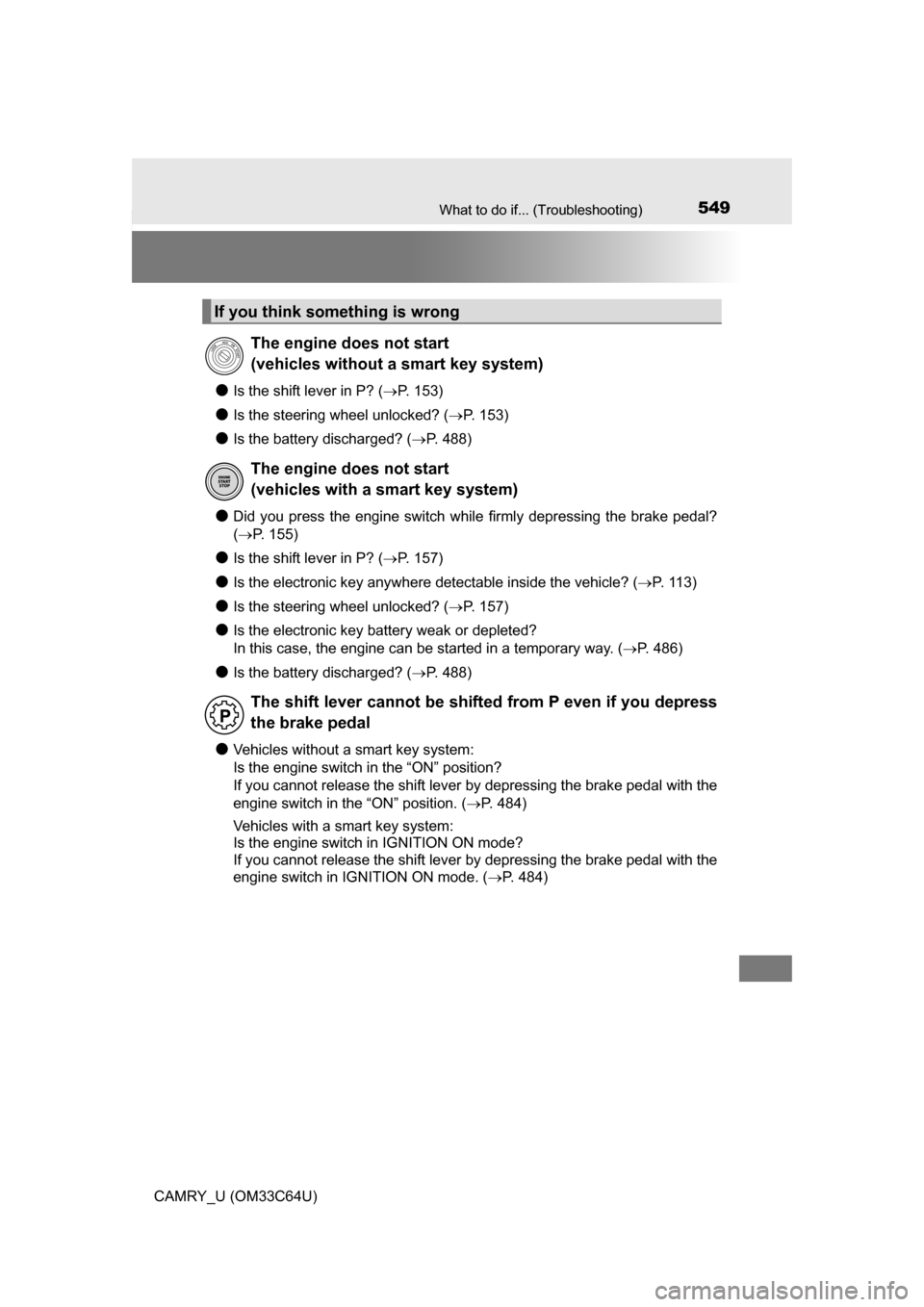2017 TOYOTA CAMRY battery
[x] Cancel search: batteryPage 490 of 568

4908-2. Steps to take in an emergency
CAMRY_U (OM33C64U)
Start the engine of the second vehicle. Increase the engine speed
slightly and maintain at that level for approximately 5 minutes to
recharge the batter y of your vehicle.
Vehicles with a smart key system: Open and close any of the doors
of your vehicle with the engine switch off.
Vehicles without a smart key system:
Maintain the engine speed of the second vehicle and turn the
engine switch to the “ON” position, then start the vehicle's engine.
Vehicles with a smart key system:
Maintain the engine speed of the second vehicle and turn the
engine switch to IGNITION ON mode, then start the vehicle's
engine.
Once the vehicle’s engine has star ted, remove the jumper cables in
the exact reverse order from which they were connected.
Once the engine starts, have the v ehicle inspected at your Toyota
dealer as soon as possible.
■ Starting the engine when the battery is discharged
The engine cannot be started by push-starting.
■ To prevent battery discharge
●Turn off the headlights and the audio system while the engine is off.
● Turn off any unnecessary electrical components when the vehicle is running
at a low speed for an extended period, such as in heavy traffic.
■ Charging the battery
The electricity stored in the battery will discharge gradually even when the
vehicle is not in use, due to natural discharge and the draining effects of cer-
tain electrical appliances. If the vehicle is left for a long time, the battery may
discharge, and the engine may be unable to start. (The battery recharges
automatically during driving.)
■ When recharging or replacing the battery
●Vehicles with a smart key system: In some cases, it may not be possible to
unlock the doors using the smart key system when the battery is dis-
charged. Use the wireless remote control or the mechanical key to lock or
unlock the doors.
● Vehicles with a smart key system: The engine may not start on the first
attempt after the battery has recharged but will start normally after the sec-
ond attempt. This is not a malfunction.
5
6
7
8
Page 491 of 568

4918-2. Steps to take in an emergency
8
When trouble arises
CAMRY_U (OM33C64U)●
Vehicles with a smart key system: The engine switch mode is memorized by
the vehicle. When the battery is reconnected, the system will return to the
mode it was in before the battery was discharged. Before disconnecting the
battery, turn the engine switch off.
If you are unsure what mode the engine switch was in before the battery dis-
charged, be especially careful when reconnecting the battery.
WARNING
■Avoiding battery fires or explosions
Observe the following precautions to prevent accidentally igniting the flam-
mable gas that may be emitted from the battery:
● Make sure each jumper cable is connected to the correct terminal and that
it is not unintentionally in contact with any other than the intended terminal.
● Do not allow the other end of the jumper cable connected to the “+” termi-
nal to come into contact with any other parts or metal surfaces in the area,
such as brackets or unpainted metal.
● Do not allow the + and - clamps of the jumper cables to come into contact
with each other.
● Do not smoke, use matches, cigarette lighters or allow open flame near
the battery.
■ Battery precautions
The battery contains poisonous and corrosive acidic electrolyte, while
related parts contain lead and lead compounds. Observe the following pre-
cautions when handling the battery:
● When working with the battery, always wear safety glasses and take care
not to allow any battery fluids (acid) to come into contact with skin, clothing
or the vehicle body.
● Do not lean over the battery.
● In the event that battery fluid comes into contact with the skin or eyes,
immediately wash the affected area with water and seek medical attention.
Place a wet sponge or cloth over the affected area until medical attention
can be received.
● Always wash your hands after handling the battery support, terminals, and
other battery-related parts.
● Do not allow children near the battery.
NOTICE
■ When handling jumper cables
When connecting the jumper cables, ensure that they do not become entan-
gled in the cooling fan or engine drive belt.
Page 502 of 568

5029-1. Specifications
CAMRY_U (OM33C64U)
Cooling system
Capacity (Reference)
2.5 L 4-cylinder (2AR-FE) engine
7.7 qt. (7.3 L, 6.4 Imp. qt.)
3.5 L V6 (2GR-FE) engine
9.6 qt. (9.1 L, 8.0 Imp. qt.)
Coolant type Use either of the following:
• “Toyota Super Long Life Coolant”
• A similar high-quality ethylene glycol-based
non-silicate, non-amine, non-nitrite, and
non-borate coolant with long-life hybrid
organic acid technology
Do not use plain water alone.
Ignition system
Spark plug
Make2.5 L 4-cylinder (2AR-FE) engine
DENSO SK16HR11
3.5 L V6 (2GR-FE) engine
DENSO FK20HR11
Gap0.043 in. (1.1 mm)
NOTICE
■ Iridium-tipped spark plugs
Use only iridium-tipped spark plugs. Do not adjust spark plug gap.
Electrical system
Battery
Open voltage at
68 F (20 C):
12.6 12.8 V Fully charged
12.2 12.4 V Half charged
11.8 12.0 V Discharged
(Voltage checked 20 minutes after the engine
and all the lights turned off)
Charging rates5 A max.
Page 518 of 568

5189-1. Specifications
CAMRY_U (OM33C64U)
Production options
weight
The combined weight of installed regular pro-
duction options weighing over 5 lb. (2.3 kg) in
excess of the standard items which they
replace, not previously considered in curb
weight or accessory weight, including heavy
duty brakes, ride levelers, roof rack, heavy
duty battery, and special trim
Rim
A metal support for a tire or a tire and tube
assembly upon which the tire beads are
seated
Rim diameter
(Wheel diameter)Nominal diameter of the bead seat
Rim size designationRim diameter and width
Rim type designationThe industry manufacturer’s designation for a
rim by style or code
Rim widthNominal distance between rim flanges
Vehicle capacity
weight (Total load
capacity)The rated cargo and luggage load plus 150 lb.
(68 kg) times the vehicle’s designated seating
capacity
Vehicle maximum load
on the tire
The load on an individual tire that is deter-
mined by distributing to each axle its share of
the maximum loaded vehicle weight, and
dividing by two
Vehicle normal load on
the tire
The load on an individual tire that is deter-
mined by distributing to each axle its share of
curb weight, accessory weight, and normal
occupant weight (distributed in accordance
with Table 1
* below), and dividing by two
Weather sideThe surface area of the rim not covered by the
inflated tire
Bead
The part of the tire that is made of steel wires,
wrapped or reinforced by ply cords and that is
shaped to fit the rim
Bead separationA breakdown of the bond between compo-
nents in the bead
Tire related termMeaning
Page 531 of 568

5319-2. Customization
9
Vehicle specifications
CAMRY_U (OM33C64U)
WARNING
■During customization
As the engine needs to be running during customization, ensure that the
vehicle is parked in a place with adequate ventilation. In a closed area such
as a garage, exhaust gases including harmful carbon monoxide (CO) may
collect and enter the vehicle. This may lead to death or a serious health
hazard.
NOTICE
■During customization
To prevent battery discharge, ensure that the engine is running while cus-
tomizing features.
Page 548 of 568

548
CAMRY_U (OM33C64U)
What to do if... (Troubleshooting)
What to do if... (Troubleshooting)
●If you lose your keys or mechanical keys, new genuine keys or mechanical
keys can be made by your Toyota dealer. ( P. 95)
●If you lose your keys or electronic keys, the risk of vehicle theft increases
significantly. Contact your Toyota dealer immediately. (P. 98)
●Is the key battery weak or depleted? ( P. 420)
●Vehicles with a smart key system:
Is the engine switch in IGNITION ON mode?
When locking the doors, turn the engine switch off. ( P. 156)
●Vehicles with a smart key system:
Is the electronic key left inside the vehicle?
When locking the doors, make sure that you have the electronic key on
your person.
●The function may not operate properly due to the condition of the radio
wave. ( P. 115)
●Is the child-protector lock set?
The rear door cannot be opened from inside the vehicle when the lock is
set. Open the rear door from outside and then unlock the child-protector
lock. (P. 103)
●The function to prevent the electronic key from being left inside the trunk
will operate and you can open the trunk as usual. Take the key out from the
trunk. ( P. 109)
If you have a problem, check the following before contacting
your Toyota dealer.
The doors cannot be locked, unlocked, opened or closed
You lose your keys
The doors cannot be locked or unlocked
The rear door cannot be opened
The trunk lid is closed with the electronic key left inside
(vehicles with a smart key system)
Page 549 of 568

549What to do if... (Troubleshooting)
CAMRY_U (OM33C64U)
●Is the shift lever in P? (P. 153)
●Is the steering wheel unlocked? ( P. 153)
●Is the battery discharged? (P. 488)
●Did you press the engine switch while firmly depressing the brake pedal?
(P. 155)
●Is the shift lever in P? ( P. 157)
●Is the electronic key anywhere detectable inside the vehicle? ( P. 113)
●Is the steering wheel unlocked? (P. 157)
●Is the electronic key battery weak or depleted?
In this case, the engine can be started in a temporary way. (P. 486)
●Is the battery discharged? (P. 488)
●Vehicles without a smart key system:
Is the engine switch in the “ON” position?
If you cannot release the shift lever by depressing the brake pedal with the
engine switch in the “ON” position. ( P. 484)
Vehicles with a smart key system:
Is the engine switch in IGNITION ON mode?
If you cannot release the shift lever by depressing the brake pedal with the
engine switch in IGNITION ON mode. ( P. 484)
If you think something is wrong
The engine does not start
(vehicles without a smart key system)
The engine does not start
(vehicles with a smart key system)
The shift lever cannot be shifted from P even if you depress
the brake pedal
Page 553 of 568

553Alphabetical index
CAMRY_U (OM33C64U)
Back-up lightsReplacing light bulb .............. 433
Wattage ................................ 506
Battery ...................................... 400 Battery checking ................... 400
If the vehicle has discharged
battery ................................ 488
Preparing and checking
before winter....................... 234
Warning message ................. 456
Bluetooth
®*
Audio system ................. ....... 288
Hands-free system (for cellular phone) ............. 289
Multimedia system ........ 288, 289
Bottle holders .......................... 344
Brake Fluid ...................................... 503
Parking brake........................ 165
Warning light ......................... 446
Brake assist ............................. 214
Break-in tips ............................ 141
Brightness control Instrument panel light control................................... 78
BSM (Blind Spot Monitor) ....... 226 Blind Spot Monitor
function ............................... 229
Rear Cross Traffic Alert function ............................... 231 Care .................................. 374, 377
Aluminum wheels ................. 375
Exterior ................................. 374
Interior .................................. 377
Seat belts.............................. 378
Cargo capacity......................... 150
CD player
*............................... 261
Chains ...................................... 235
Child restraint system............... 54
Booster seats, definition ......... 55
Booster seats, installation....... 62
Convertible seats, definition ............................... 55
Convertible seats,
installation ............................ 61
Front passenger occupant classification syst em ............ 47
Infant seats, definition............. 55
Infant seats, installation .......... 60
Installing CRS with LATCH anchors ................................ 59
Installing CRS with seat belts...................................... 60
Installing CRS with top tether strap ..................................... 63
BC
*: For vehicles with a Entune Premium Audio or Entune Audio Plus,
refer to the “NAVIGATION AND MULTIMEDIA SYSTEM OWNER'S MANUAL”.